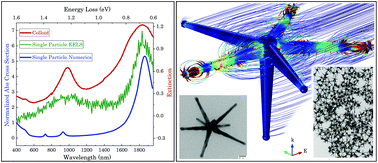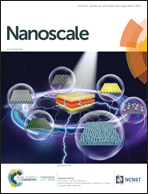Colloidal plasmonic nanostar antennas with wide range resonance tunability†
Abstract
Gold nanostars display exceptional field enhancement properties and tunable resonant modes that can be leveraged to create effective imaging tags, phototherapeutic agents, and hot electron-based photocatalytic platforms. Despite having emerged as the cornerstone among plasmonic nanoparticles with respect to resonant strength and tunability, some well-known limitations have hampered their technological implementation. Herein we tackle these recognized intrinsic weaknesses, which stem from the complex, and thus computationally untreatable morphology and the limited sample monodispersity, by proposing a novel 6-spike nanostar, which we have computationally studied and synthetically realized, as the epitome of 3D plasmonic nanoantenna with wide range plasmonic tunability. Our concerted computational and experimental effort shows that these nanostars combine the unique advantages of nanostructures fabricated from the top-down and those synthesized from the bottom-up, showcasing a unique plasmonic response that remains largely unaltered on going from the single particle to the ensemble. Furthermore, they display multiple, well-separated, narrow resonances, the most intense of which extends in space much farther than that observed before for any plasmonic mode localized around a colloidal nanostructure. Importantly, the unique close correlation between morphology and plasmonic response leads the resonant modes of these particles to be tunable between 600 and 2000 nm, a unique feature that could find relevance in cutting edge technological applications.

- This article is part of the themed collection: Advisory Board research selection


 Please wait while we load your content...
Please wait while we load your content...
